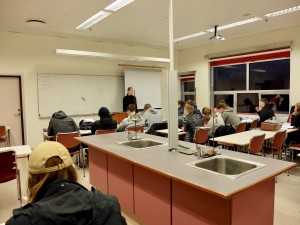Alma Mjöll Ólafsdóttir is a performance maker. Alma attended Lecture For Every One at Gardabaer Compresensive Secondary School.
Fjölbraut i Garðabæ. High School. A grand building. Corridors. Students. This is a universe of its own. You feel that as soon as you come through the door. I am with two girls. Both of them high school students. Me, I am a guest in this reality. Not a teacher. Not a student. A witness.
We are invited into the school’s library. By a friendly woman who seems happy to meet us. Happy to encounter a visitor to this reality. Can I offer you coffee? she says. She takes us to the teacher’s cafeteria. It is almost empty. As she is introducing the reality of the school to us two teachers approach. Are you a student teacher? one asks. Trying to situate us within this reality. No I reply. What are you? Silence. Marta, one of the girls replies: we are here for a lecture. For ,,Everybody’s Spectacular”. Lecture For Every One.
Theatre enters this reality. A rupture. A meeting.
The friendly librarian takes us back to the library. On the way back she explains how they are renovating the library. Making it more suitable for current times. Adding space for the art students to practice their studies. There is beauty in the way that she knows that we are there for a short visit but even so she feels the need to introduce us to her reality, this institution that she is proud to be a part of. We enter the library again. Take a seat by a table, waiting for a professor to come pick us up. On the next table there are students discussing current events on Instagram. They are quite loud. I have a feeling that there are three different realities at least sharing a space in the library at this very moment. The proud and friendly librarian who is doing her job, gets paid and has a great passion for her job at this institution. Then there are these kids on the next table. Students. Temporary inhabitants in the reality of the librarian. I suddenly remember how I felt in high school, there was this awareness of the temporary embedded with the feeling like the whole world existed just within the building of my high school. This kind of temporary foreverness. Then there is reality number three. Us, the guests. A mixed crowd. Me, having left the temporary foreverness and now acting as a visitor in it and then the two other girls traveling from one temporary foreverness to another, guests within the space in time that is high school.
The text is distant. From another reality. It is a bit poetic. Poetic can be distant. You have to decide to engage with the poetic. You have to want to make meaning of it. In this particular circumstance I feel like this reality is hesitant towards a visitor. Not unfriendly but somehow uninviting. Which makes the text more distant than if you were in a circumstance where the whole room decides to engage with the poetic, wanting to make a meaning of it. The thing is in fact that a few days after the lecture, what stays with me is more the situation than the text itself. I remember themes such as ‘living together’ and ‘care’, beautiful words and they should be put in situations, whether or not the situation asked for it. But most of the words have vanished. Perhaps because of how peculiar this particular situation was.
Maybe now is a good time to remember that the witness is never just a witness. This is my reading on the situation. Of course there are some objective signs that give me something to build on. The students are on their phones and computers. And it seems that they are not willing to engage with the message nor the body that delivers it. I fear that my fears put a lot of salt and pepper on the situation.
My fear that the theatre is a distant medium. My fear that we as a society have decided not to engage outside of our realities. My fear that phones are an easy escape route when having to engage.
I have not lost all hope. There is still something valid and interesting in this particular friction. The idea and the commitment of the friction alone is worth witnessing. The rupture, the interruption is important.
-Alma Mjöll
